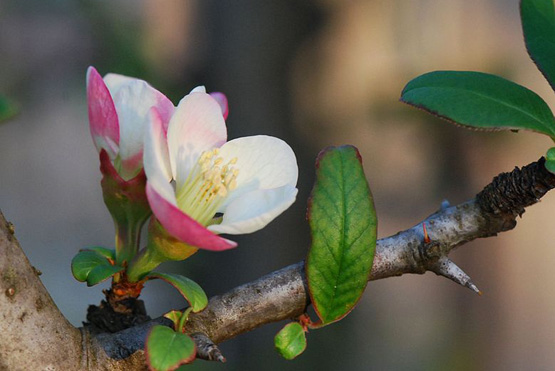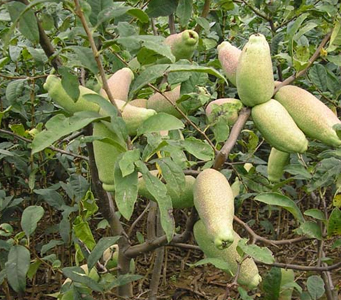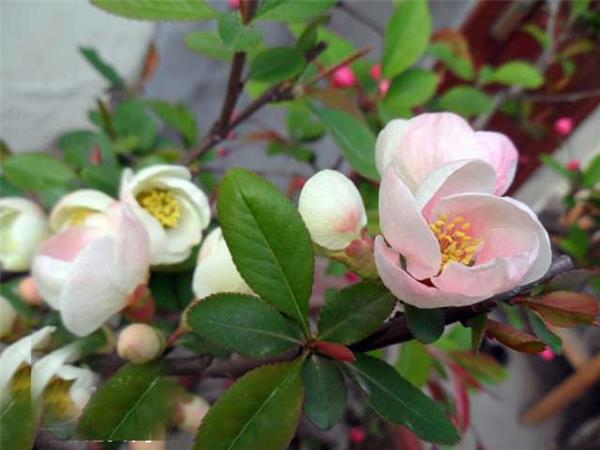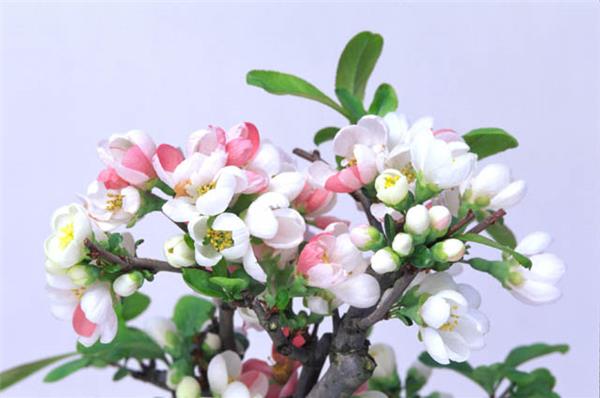Culture method of papaya begonia can papaya begonia fruit be eaten
Papaya begonia is a widely used plant in the garden, and now potted papaya begonia in the courtyard is also very popular. The seeds, flowers, fruits and tree trunks of papaya Begonia have good utilization value. Today, the editor is going to introduce to you the culture method of papaya begonia. Can papaya begonia fruit be eaten? Let's take a look.

A brief introduction of papaya Begonia
Papaya Begonia is a genus of Rosaceae, small deciduous trees, often spiny; simple leaves alternate, with large stipules; flowers solitary or clustered, often first leaves open; sepals 5, colored; stamens numerous; petals 5, large; stamens 20 or many; ovary inferior, 5-loculed, with ovules numerous; pear fleshy, large. Born under forest margins or valleys on mountain slopes, 800-1100 m above sea level. The fruit is used for medicine and has the effects of expelling wind, relieving qi, relaxing muscles and relieving pain. It is mostly cultivated in the garden for greening. This plant is also referred to as papaya, but it is different from the subtropical fruit papaya (also referred to as papaya). Although it is very different, it is still easy to be confused.
Culture method of papaya Begonia
Papaya Begonia is a plant of the genus papaya of Rosaceae. It is a small deciduous tree with spines. It likes warmth and has a certain degree of cold tolerance. The soil is required to be well drained and not resistant to moisture and salinity.
Papaya and begonia are generally planted in many places, but potted plants can also be made for pile scenery. The suitable planting period is before sprouting in early spring or after defoliation in early winter. When the seedling comes out of the nursery, keeping the intact root system of the seedling is one of the keys to the survival of planting. Generally, large seedlings should be planted with soil balls, and small seedlings should stay in the lodging soil according to the situation. The tending and management of seedlings should be strengthened after planting, and the soil should be kept loose and fertile.

A batch of pond mud or fertile soil can be cultivated in the rhizosphere every autumn and winter. A pruning was carried out from the defoliation to the sprouting in early spring to cut off the weak branches, disease and insect branches in order to keep the crown open, ventilated and transparent. In order to promote the vigorous flowering of the plant, it is necessary to truncate the overgrown branches to reduce the nutrient consumption of germination, so that the remaining axillary buds can get more nutrients and form more flowering and fruiting branches. Fruit branches and middle branches need not be pruned. During the growth period, if the heart can be removed in time and the vegetative growth is restricted in the early stage, the effect will be more significant. The pile scenery of potted plants should be controlled in this way.
In case of spring drought, it is necessary to carry out 1-2 times of irrigation, and pay attention to the control of beetles, leaf rollers, aphids, pocket moths, red spiders and other pests, as well as rot, red star disease and so on.
Can papaya and crabapple be eaten?
Papaya and crabapple fruit can be eaten. Non-toxic. Very sour, shaped like a big green Hawthorn. The skin is smooth and non-greasy. The skin is light cyan, the color is similar to towel gourd, and towel gourd has the same sewing and crisp texture.
1. Shengjin to quench thirst: begonia contains sugars, a variety of vitamins and organic acids, which can help replenish the intracellular fluid of the human body, thus having the effect of invigorating body and relieving thirst.
two。 Invigorating the spleen and appetizer: begonia fruit is rich in vitamins, organic acids and according to quality, which can help the stomach and intestines to digest food, so it can be used to treat dyspepsia and abdominal distension.

3. Astringent intestines and stop dysentery: Begonia taste sweet and slightly sour, sweet can slow, acid can be astringent, with convergence to stop diarrhea, and stop dysentery function, can treat diarrhea, diarrhea, stool thinning and other diseases
4. Supplementary nutrition: begonia contains a large number of essential nutrients, such as sugars, vitamins, organic acids, etc., which can provide nutrients to the human body and improve immunity.
Matters needing attention in the culture of papaya and begonia
1. After the defoliation of papaya and begonia in winter, the plant should be trimmed and shaped once, and the withered branches, weak branches and other branches that affect the shape should be cut off, and more strong branches should be left to make the flowers and fruits fruitful in the coming year.
2. Chaenomeles sinensis is cold-resistant, and it is best to bury the flowerpot underground or put it indoors above 0 ℃. If the temperature is too high, the plant will sprout ahead of time, but it is disadvantageous to the growth of the second year, so the highest temperature should not exceed 10 ℃, so that the papaya crabapple can fully dormancy.

Cultivation and Management of Papaya Begonia
Generally multi-row ground planting, but you can also make pile scenery to implement potted plants. The suitable planting period is before sprouting in early spring or after defoliation in early winter. When the seedling comes out of the nursery, keeping the intact root system of the seedling is one of the keys to the survival of planting. Generally, large seedlings should be planted with soil balls, and small seedlings should stay in the lodging soil according to the situation. The tending and management of seedlings should be strengthened after planting, and the soil should be kept loose and fertile. A batch of pond mud or fertile soil can be cultivated in the rhizosphere every autumn and winter. A pruning was carried out from the defoliation to the sprouting in early spring to cut off the weak branches, disease and insect branches in order to keep the crown open, ventilated and transparent. In order to promote the vigorous flowering of the plant, it is necessary to truncate the overgrown branches to reduce the nutrient consumption of germination, so that the remaining axillary buds can get more nutrients and form more flowering and fruiting branches. Fruit branches and middle branches need not be pruned. During the growth period, if the heart can be removed in time and the vegetative growth is restricted in the early stage, the effect will be more significant. The pile scenery of potted plants should be controlled in this way.
In case of spring drought, it is necessary to carry out 1-2 times of irrigation, and pay attention to the control of beetles, leaf rollers, aphids, pocket moths, red spiders and other pests, as well as rot, red star disease and so on.

The above content is the introduction of the cultivation method of papaya Begonia by the editor. Do you understand it? I hope it will be helpful to you.
Always keep the soil loose and fertile. A batch of pond mud or fertile soil can be cultivated in the rhizosphere every autumn and winter. A pruning was carried out from the defoliation to the sprouting in early spring to cut off the weak branches, disease and insect branches in order to keep the crown open, ventilated and transparent. In order to promote the vigorous flowering of the plant, it is necessary to truncate the overgrown branches to reduce the nutrient consumption of germination, so that the remaining axillary buds can get more nutrients and form more flowering and fruiting branches. Fruit branches and middle branches need not be pruned. During the growth period, if the heart can be removed in time and the vegetative growth is restricted in the early stage, the effect will be more significant. The pile scenery of potted plants should be controlled in this way.
In case of spring drought, it is necessary to carry out 1-2 times of irrigation, and pay attention to the control of beetles, leaf rollers, aphids, pocket moths, red spiders and other pests, as well as rot, red star disease and so on.

The above content is the introduction of the cultivation method of papaya Begonia by the editor. Do you understand it? I hope it will be helpful to you.
Related
- Wuhan Hospital Iron Tree Blooming Result Was Instantly Frightened by the Gardener Master
- Which variety of camellia is the most fragrant and best? Which one do you like best?
- What is the small blue coat, the breeding methods and matters needing attention of the succulent plant
- Dormancy time and maintenance management of succulent plants during dormancy
- Minas succulent how to raise, Minas succulent plant pictures
- What are the varieties of winter succulent plants
- How to raise succulent plants in twelve rolls? let's take a look at some experience of breeding twelve rolls.
- Attention should be paid to water control for succulent plants during dormant period (winter and summer)
- Watering experience of twelve rolls of succulent plants
- Techniques for fertilizing succulent plants. An article will let you know how to fertilize succulent plants.



